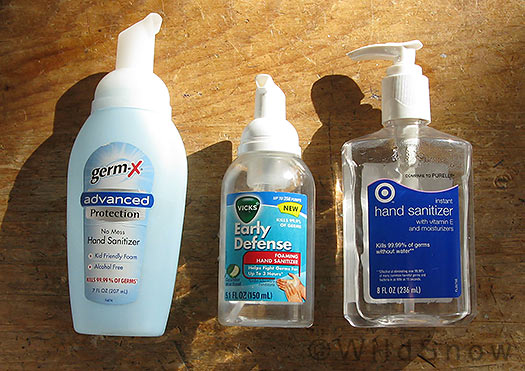It is a known fact that heavy exercise reduces your resistance to colds and flu for a period after your workout. Problem is, that’s when you leave the crisp clean backcountry and dive into a bar or eatery where you surround yourself with human petri dishes. Another fact: most colds and flu are transmitted by your hands.
I used to have a huge problem with this. Every winter I’d get into great shape — then the viruses would hit. A couple of colds, perhaps the flu, and a whole month or more of the best backcountry powder skiing would be down the tubes. Sometimes I’d end up having to travel while sick, or worse, having to to get out on skis and participate in industry events while feeling no better than a dog coughing up a hairball.
But all that has changed, and I attribute 90% of my nearly cold and flu free life to the use of hand sanitizers. But which one works? And what about bacteria becoming resistant to sanitizers?

Hand sanitizers, Benzalkonium chloride (BC) to left, triclosan based solution in middle, 62% alcohol to right.
Here is what I’ve found out, and how I use the stuff to keep backcountry skiing instead of slurping chicken soup and watching my DVD collection for the 50th time.
Most hand sanitizers use one of three chemicals: Alcohol, triclosan, or Benzalkonium Chloride (BC). Bacteria and viruses can be resistant to triclosan or BC, but either chemical is still adequately effective for consumer use, as far as I can tell from my research and based on personal experience. Alcohol is the most toxic to bugs — nearly all bacteria and viruses can’t resist dying when they contact it, and most will never develop resistance to the correct concentration. (More here about pathogen resistance.)
Problem is, alcohol based hand sanitizers don’t persist on your skin, and thus need to be used after every contact, or at least super regularly when you’re in a public place. More, even alcohol based compounds that include lotion may dry your hands out to the point of painful cracking. Triclosan and BC based sanitizers build up on your skin and provide ongoing protection even without constant use, and they don’t dry out your skin any more than hand washing. Triclosan is questionable as something you want on your skin or transferred into your body from hand contact with your food, while normal use amounts of BC appear to be totally non-toxic and non-carcinogenic.
My strategy with hand sanitizers, which appears to work, is to use both alcohol and BC based products (as well as old fashioned hand washing several times a day). While traveling or at trade shows, parties or the gym I use the benzalkonium since in those situations I’d have to be applying alcohol every few minutes for it to be reliable. When things slow down, such as during road trips, I use the alcohol based stuff after things such as gasoline stops. Triclosan based sanitizer is too suspect for my taste, so I use it when I can’t find the BC based stuff, but avoid it when I can.
I’m not that fastidious of a person, but I did get tired of being sick for weeks every winter. Not saying that can’t happen again, but I’ve had the healthiest winters of my life over the last few years when I’ve been conscientiously using hand sanitizer.
If you’re shopping, remember that alcohol based sanitizers need at least a 60% concentration. Benzalkonium is effective at much smaller concentrations. Compounds with hand lotion may make your hands sticky, so experiment with different products.
Folks made fun of me for covering snow tires on a backcountry skiing blog. Now, hand sanitizer. Your opinions oh esteemed WildSnowers?
WildSnow.com publisher emeritus and founder Lou (Louis Dawson) has a 50+ years career in climbing, backcountry skiing and ski mountaineering. He was the first person in history to ski down all 54 Colorado 14,000-foot peaks, has authored numerous books about about backcountry skiing, and has skied from the summit of Denali in Alaska, North America’s highest mountain.
